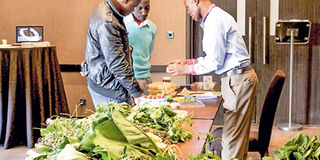Tips on earning more from vegetables

An assortment of green vegetables. Perishability is one of the problems affecting trade and consumption of vegetables since they spoil faster often before reaching the final user. FILE PHOTO | NATION MEDIA GROUP
What you need to know:
- Amaranth contains high-quality proteins, lipids, carbohydrates, minerals, dietary fibres, omega-3 fatty acids, omega–6 fatty acids, vitamins, flavonoids, phenolic compounds, tocopherols and phytates.
- Traditionally, African leafy vegetables were dried, put in clay pots, covered and stored next to the fireplace. This process prevented development of bread mould.
- Fresh vegetables in the market cost Sh35 per kilo. Therefore, a tonne (1,000kg) of fresh vegetables from the farm will cost Sh35,000.
- After blanching and drying, you recover 10 per cent of dry vegetables; this means 30kg from 300kg. Therefore, a tonne of fresh vegetables will make 300 sachets of 100g each.
Black night shade (managu or osuga), spider plant (saga), jute mallow (mrenda), crotalaria (mitoo), amaranth (terere), bacella alba (nderema), cowpeas leaves (kunde) and pumpkin leaves (sebebe) have one thing in common – they are all classified as African indigenous vegetables.
Demand for these vegetables has risen significantly due to increased consumer awareness on their nutritional importance.
Perishability, however, is one of the problems affecting trade and consumption of the vegetables. They spoil faster before reaching the final user.
Value addition can, thus, help alleviate the problem. Dried vegetables stored at room temperature, for instance, can stay for up to two years.
Nutritional and health benefits
Amaranth contains high-quality proteins, lipids, carbohydrates, minerals, dietary fibres, omega-3 fatty acids, omega–6 fatty acids, vitamins, flavonoids, phenolic compounds, tocopherols and phytates.
On dry weight basis, amaranth contains 17–38 per cent protein content. Lysine, a limiting amino acid in cereals largely consumed in Kenya, constitutes five per cent of the total amaranth protein. The high fibre content of the vegetables can reduce blood sugar after a high carbohydrate meal consumption.
This is because the fibres have a lower glycemic index and reduce constipation. Calcium and phosphorous in the vegetables are vital in general bone health. Amaranth seeds are gluten-free pseudo cereal, which can be consumed by persons that are allergic to gluten protein.
These vegetables also contain a higher level of folates and bioactive peptides, which are vital in the development of the spinal cord and the brain of an embryo when consumed by pregnant mothers.
Value addition
The vegetable seeds and leaves can be dried and used singly or to fortify other foods to enhance their nutritional value.
Amaranth is also grown for seeds and leaves. These seeds are used in the fortification of other foods.
Drying vegetables
Drying has been used for decades as a way of increasing the shelf life of food products. It lowers water activity, reducing microbial and chemical spoilage of food.
RETARDS ENZYMATIC ACTION
Traditionally, African leafy vegetables were dried, put in clay pots, covered and stored next to the fireplace. This process prevented development of bread mould.
Today, scientists have bettered this crude science into a process that involves blanching of the vegetables in hot boiling water for 3-4 minutes followed by ice cold water plunging before drying.
Sodium bicarbonate or table salt (sodium chloride) is added to the blanching water. Hot water blanching retards enzymatic action hence retaining vegetable nutrients (flavour, colour and texture), decontaminates the vegetable’s surface of dirt, bacteria and moulds, fixes the chlorophylls brightening the colour, helps to retard loss of vitamins and softens vegetables, hence making them easier to pack.
Further, hot water blanching helps retain important nutritious compounds such as beta carotene; a precursor of vitamin A. After blanching, the vegetables are dehydrated to about 10 per cent moisture content. Drying is done in a polythene greenhouse or in an electric dryer and then packed in polythene sachets.
Cost-benefit analysis of vegetable value addition
Fresh vegetables in the market cost Sh35 per kilo. Therefore, a tonne (1,000kg) of fresh vegetables from the farm will cost Sh35,000.
What happens when these vegetables are dried? From the farm, vegetables are weighed and sold together with the stems.
An average stem and branch-to-leaf ratio for the vegetables is about 3:7. This means that for a tonne, you get 300kg of plucked leaves.
After blanching and drying, you recover 10 per cent of dry vegetables; this means 30kg from 300kg. Therefore, a tonne of fresh vegetables will make 300 sachets of 100g each.
A 100g sachet of dry African leafy vegetables retails for Sh350. Therefore, after selling the 300 sachets, one will be able to make Sh105,000.
Therefore, farmers need to be educated on using best seeds, marketing channels and value addition.
The writer is based at the Department of Dairy, Food Science and Technology, Egerton University




